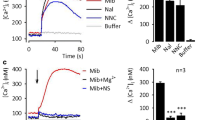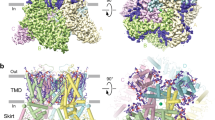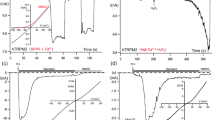Abstract
TRPM2 is a Ca2+-permeable non-selective cation channel that uniquely is activated by intracellular ADP-ribose. To date, only one pharmacological blocker of this channel, namely flufenamic acid (FFA), has been described. Here we demonstrate, using patch clamp electrophysiology, that the antifungal imidazoles clotrimazole and econazole inhibit ADP-ribose-activated currents in HEK-293 cells expressing recombinant human TRPM2 (hTRPM2). For both compounds, all concentrations in a range from 3 μM to 30 μM produced an essentially complete inhibition of the TRPM2-mediated current. The rate of current antagonism was dependent on the concentration applied, with higher concentrations producing faster block. In addition, decreasing extracellular pH accelerated inhibition of TRPM2 by both clotrimazole and econazole; extracellular alkalisation produced the converse effect. Additional experiments indicated hTRPM2 activation was required for the antagonism of either compound to develop, and that neither compound blocked from the intracellular face of the plasma membrane. ADP-ribose-activated whole-cell and single-channel currents in the rat insulinoma cell-line CRI-G1 were also antagonised by clotrimazole. Contrary to the observations made with hTRPM2, antagonism in CRI-G1 cells could be largely reversed following clotrimazole removal. These experiments suggest that imidazole antifungals may be useful tool antagonists for future studies of TRPM2 function.







Similar content being viewed by others
References
Bandell M, Story GM, Hwang SW, Viswanath V, Eid SR, Petrus MJ, Earley TJ, Patapoutian A (2004) Noxious cold ion channel TRPA1 is activated by pungent compounds and bradykinin. Neuron 41:849–857
Brugnara C (2003) Sickle cell disease: from membrane pathophysiology to novel therapies for prevention of erythrocyte dehydration. J Pediatr Hematol Oncol 25:927–933
Ceni C, Muller-Steffners H, Lund F, Pochon N, Schweitzer A, de Waard M, Schuber F, Villaz M, Moutin M-J (2003) Evidence for an intracellular ADP-ribosyl cyclase/NAD+-glycohydrolase in brain from CD38-deficient mice. J Biol Chem 278:40670–40678
Chan SLF, Pallet AL, Morgan NG (1997) Clotrimazole and efaroxan stimulate insulin secretion by different mechanisms in rat pancreatic islets. Naunyn-Schmiedebergs Arch Pharmacol 356:763–768
Clapham DE, Montell C, Schultz G, Julius D (2003) International union of pharmacology. XLIII. Compendium of voltage-gated ion channels: transient receptor potential channels. Pharmacol Rev 55:591–596
Fearon IM, Ball SG, Peers C (2000) Clotrimazole inhibits the recombinant human cardiac L-type Ca2+ channel alpha 1C subunit. Br J Pharmacol 129:547–554
Fonfria E, Marshall ICB, Benham CD, Boyfield I, Brown JB, Hill K, Hughes JP, Skaper SD, McNulty S (2004) TRPM2 channel opening in response to oxidative stress is dependent on activation of poly(ADP-ribose) polymerase. Br J Pharmacol 143:186–192
Fromtling RA (1988) Overview of medically important antifungal azole derivatives. Clin Microbiol Rev 1:187–217
Hegemann L, Toso SM, Lahijani KI, Webster GF, Uitto J (1993) Direct interaction of antifungal azole-derivatives with calmodulin: a possible mechanism for their therapeutic activity. J Invest Dermatol 100:343–346
Heiner I, Eisfeld J, Halaszovich CR, Wehage E, Jungling E, Zitt C, Luckhoff A (2003) Expression profile of the transient receptor potential (TRP) family in neutrophil granulocytes: evidence for currents through long TRP channel 2 induced by ADP-ribose and NAD. Biochem J 371:1045–1053
Hernandez-Benito MJ, Macianskiene R, Sipido KR, Flameng W, Mubagwa K (2001) Suppression of transient outward potassium currents in mouse ventricular myocytes by imidazole antimycotics and by glybenclamide. J Pharmacol Exp Ther 298:598–606
Herson PS, Lee K, Pinnock RD, Hughes J, Ashford ML (1999) Hydrogen peroxide induces intracellular calcium overload by activation of a non-selective cation channel in an insulin-secreting cell line. J Biol Chem 274:833–841
Hill K, Benham CD, McNulty S, Randall AD (2004) Flufenamic acid is a pH-dependent antagonist of TRPM2 channels. Neuropharmacology 47:450–460
Inamura K, Sano Y, Mochizuki S, Yokoi H, Miyake A, Nozawa K, Kitada C, Matsushime H, Furuichi K (2003) Response to ADP-ribose by activation of TRPM2 in the CRI-G1 insulinoma cell line. J Membr Biol 191:201–207
Isaev NK, Stelmashook EV, Dirnagl U, Andreeva NA, Manuhova L, Vorobjev VS, Sharonova IN, Skrebitsky VG, Victorov IV, Katchanov J, Weih M, Zorov DB (2002) Neuroprotective effects of the antifungal drug clotrimazole. Neuroscience 113:47–53
Jager H, Dreker T, Buck A, Giehl K, Gress T, Grissmer S (2004) Blockage of intermediate-conductance Ca2+-activated K+ channels inhibit human pancreatic cancer cell growth in vitro. Mol Pharmacol 65:630–638
Jensen BS, Strobaek D, Christophersen P, Jorgensen TD, Hansen C, Silahtaroglu A, Olesen SP, Ahring PK (1998) Characterization of the cloned human intermediate-conductance Ca2+-activated K+ channel. Am J Physiol 275:C848–C856
Jordt SE, Bautista DM, Chuang HH, McKemy DD, Zygmunt PM, Hogestatt ED, Meng ID, Julius D (2004) Mustard oils and cannabinoids excite sensory nerve fibres through the TRP channel ANKTM1. Nature 427:260–265
Kraft R, Grimm C, Grosse K, Hoffmann A, Sauerbruch S, Kettenmann H, Schultz G, Harteneck C (2004) Hydrogen peroxide and ADP-ribose induce TRPM2-mediated calcium influx and cation currents in microglia. Am J Physiol Cell Physiol 286:C129–C137
Lajoix A-D, Reggio H, Chardes T, Peraldi-roux S, Tribillac F, Roye M, Dietz S, Broca C, Manteghetti M, Ribes G, Wollheim CB, Gross R (2001) A neuronal isoform of nitric oxide synthase expressed in pancreatic β-cells controls insulin secretion. Diabetes 50:1311–1323
McHugh D, Flemming R, Xu SZ, Perraud AL, Beech DJ (2003) Critical intracellular Ca2+ dependence of transient receptor potential melastatin 2 (TRPM2) cation channel activation. J Biol Chem 278:11002–11006
MacNeil S, Dawson RA, Crocker G, Tucker WF, Bittiner B, Singleton JG, Hunter T, Tierney DF (1993) Antiproliferative effects on keratinocytes of a range of clinically used drugs with calmodulin antagonist activity. Br J Dermatol 128:143–150
Nilius B, Prenen J, Vennekens R, Hoenderop JG, Bindels RJ, Droogmans G (2001) Pharmacological modulation of monovalent cation currents through the epithelial Ca2+ channel ECaC1. Br J Pharmacol 134:453–462
Perraud AL, Fleig A, Dunn CA, Bagley LA, Launay P, Schmitz C, Stokes AJ, Zhu Q, Bessman MJ, Penner R, Kinet JP, Scharenberg AM (2001) ADP-ribose gating of the calcium-permeable LTRPC2 channel revealed by Nudix motif homology. Nature 411:595–599
Smith MA, Herson PS, Lee K, Pinnock RD, Ashford ML (2003) Hydrogen-peroxide-induced toxicity of rat striatal neurones involves activation of a non-selective cation channel. J Physiol 547:417–425
Story GM, Peier AM, Reeve AJ, Eid SR, Mosbacher J, Hricik TR, Earley TJ, Hergarden AC, Andersson DA, Hwang SW, McIntyre P, Jegla T, Bevan S, Patapoutian A (2003) ANKTM1, a TRP-like channel expressed in nociceptive neurons, is activated by cold temperatures. Cell 112:819–829
Thomas GP, Karmazyn M, Zygmunt AC, Antzelevitch C, Narayanan N (1999) The antifungal antibiotic clotrimazole potently inhibits L-type calcium current in guinea-pig ventricular myocytes. Br J Pharmacol 126:1531–1533
Wilson HL, Dipp M, Thomas JM, Lad C, Galione A, Evans AM (2001) Adp-ribosyl cyclase and cyclic ADP-ribose hydrolase act as a redox sensor. A primary role for cyclic ADP-ribose in hypoxic pulmonary vasoconstriction. J Biol Chem 276:11180–11188
Acknowledgements
The authors thank Dr A. Scharenberg (University of Washington) for the kind gift of the HEK293-TRPM2 cell line. K.H. is in receipt of EU Framework V Postdoctoral Fellowship.
Author information
Authors and Affiliations
Corresponding author
Rights and permissions
About this article
Cite this article
Hill, K., McNulty, S. & Randall, A.D. Inhibition of TRPM2 channels by the antifungal agents clotrimazole and econazole. Naunyn-Schmiedeberg's Arch Pharmacol 370, 227–237 (2004). https://doi.org/10.1007/s00210-004-0981-y
Received:
Accepted:
Published:
Issue Date:
DOI: https://doi.org/10.1007/s00210-004-0981-y




